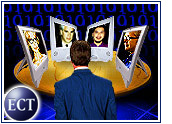
The Internet has brought dramatic changes to the way companies communicate and people conduct their business relationships. One of the hottest marketing trends for businesses across all industry lines involves using the power of the Internet to provide virtual meeting spaces. Web conferencing and Web-based seminars are quickly replacing traditional business travel and telephone conference-call strategies.
With the surge in demand around Web conferencing technologies rapidly increasing, IDC predicts that the conferencing-applications market will grow from nearly US$600 million in revenue in 2003 to more than $1.1 billion in 2007.
“The world is changing. It is not as safe as it used to be. People are not willing to travel for business like they were before,” Kevin Bethke, CEO of Interactive Video Technologies, told the E-Commerce Times. IVT is a leading provider of communication software designed to enable the creation, management deployment and measurement of live and on-demand presentations.
According to Frost & Sullivan’s David Alexander, the industry research manager of the firm’s multimedia conferencing and collaboration group, Web conferencing is a hot and growing market.
“We are seeing a high level of convergence. New solutions have integrated audio and video for a full online environment,” Alexander told the E-Commerce Times, pointing out that technology has progressed to the point that full virtual meetings are now possible. Soon, using Web conferencing will be just like sitting on the other side of the conference table, he said.
More Than Niche Services
Two of the biggest players in the Web-conferencing market are WebEx, which has two thirds of the market share, and Microsoft, which purchased number two player PlaceWare. Another big player, according to analysts, is RainDance, formerly Evoke Communications. Capping the list of Web-conferencing giants is Netspoke.
The goal of any name-branding campaign is to have a corporate identity become synonymous with the product or service itself. That seems to be the case with the name recognition WebEx enjoys. Using Web conferencing is becoming so commonplace that many refer to the process as “Doing a WebEx,” according to Jack Witherell, COO of Netspoke.
More companies are getting involved in this marketing approach, noted Witherell. He said Web conferencing and seminars on the Web are an effective way for companies to present information to large audiences with 50 or 100 attendees. It also is an effective method for presenting details to small audiences.
“I’ve seen a lot of growth in both of these areas. This is a shift. The common use for Web casts used to be presentations to medium-sized audiences of 20 people. But that is gone by the wayside,” said Witherell.
Response to Changing Conditions
The Internet is making it possible for small companies to go international. It is this trend toward globalization, said Bethke, that is partly driving the growth of the Web-seminar marketplace. Another driving point is the rapid switch in the U.S. marketplace from an asset-based economy to a services-based economy, he said.
The success of Web-casting technology is leading to a change in marketing strategies. Traditional marketing plans called for reaching large audiences through several media venues. Web conferencing was primarily used for sales team collaboration. Web casting was used to address very large audiences, said Bethke.
Frost & Sullivan’s David Alexander sees Web casting developing into more of a collaborative meeting environment for all sizes of audience. Web conferencing is more collaborative than just making one-sided presentations, he said. It is changing the way people are working and is bridging the gap of distance.
“It serves many purposes. Presenters can send a link for participants to view information during a virtual meeting. Participants can see updates to spreadsheets at the same time and input changes in real time,” Alexander said.
“It is also an effective sales and marketing tool and is very reliable as a training tool. It is an ideal way to get information to shareholders. It is also tool being used by help desks.”
Jack Witherell sees the Web-marketing landscape continuing to evolve. “Web seminars are not going to stay on their own,” he said. “The industry will be impacted by convergence with different media and tools, including audio, video, and instant-messaging presence during a conference. The process is heading to a follow-me conference approach that first finds the participant on a cell phone and invites him to the computer conference.”
Finding Your Audience
The question that many first adopters of Web casts and Web seminars ask is how to find an audience. The answer, say Internet marketing experts, is different depending on your purpose.
Most audience-acquisition strategies, however, involve more traditional e-mail campaigns to established customers. Variations involve invitations to potential customers who make initial contact through phone or by visiting Web sites.
Steve Uhring, vice president of sales and marketing for Web conferencing vendor LiveOffice, uses several traditional and innovative advertising tools.
“To make the Web conference model successful, we have to spend recurring time in front of the customer. So the Web marketing approach is becoming a driving factor. It allows us to meet quarterly with our customers and keep the customer engaged. This is something that enhances customer relations,” he told the E-Commerce Times.
The bottom line, he said, is learning to become fairly aggressive in going on the Internet.
Success Stories
Harris InfoSource, a division of Dun & Bradstreet, has been using Netspoke for Web casts and Web-based seminars since 2001. The company’s salespeople do roughly 200 Web conferences a month. LeeAnn Craft, a spokesperson for the company, said company officials could not be happier with the results. It cuts down on the sales process. She said the company uses it in response to the customers’ inquiries.
“We also do large audience presentations. The presentations usually allow us to close a majority of our sales presentations. The Web conferences have generated several million dollars, so it is very effective,” she told the E-Commerce Times.
Live Office’s Uhring agrees. From a cost perspective, Internet marketing is a much more effective way to go. The challenge for his firm was making the presentations sufficiently warm and fuzzy to satisfy its large financial clientele.
The use of two-way video and combining instant messaging with Web conferencing features solved that challenge, he said. “We are selling more with it now than ever before,” he told the E-Commerce Times.
ScanAlert, an Internet security provider, uses formal presentations broadcast on the Web. Nigel Ravenhill, marketing director for ScanAlert, said this approach to Web marketing has worked well for his company, especially at trade shows. The Web marketing strategies have added to the company’s credibility, he said.
Ravenhill scripts the messages extensively. He said the process is similar to creating PowerPoint presentations that need a voice to back them up. “It was definitely worthwhile doing and is a good addition to our marketing tools,” he told the E-Commerce Times.






















































Social Media
See all Social Media